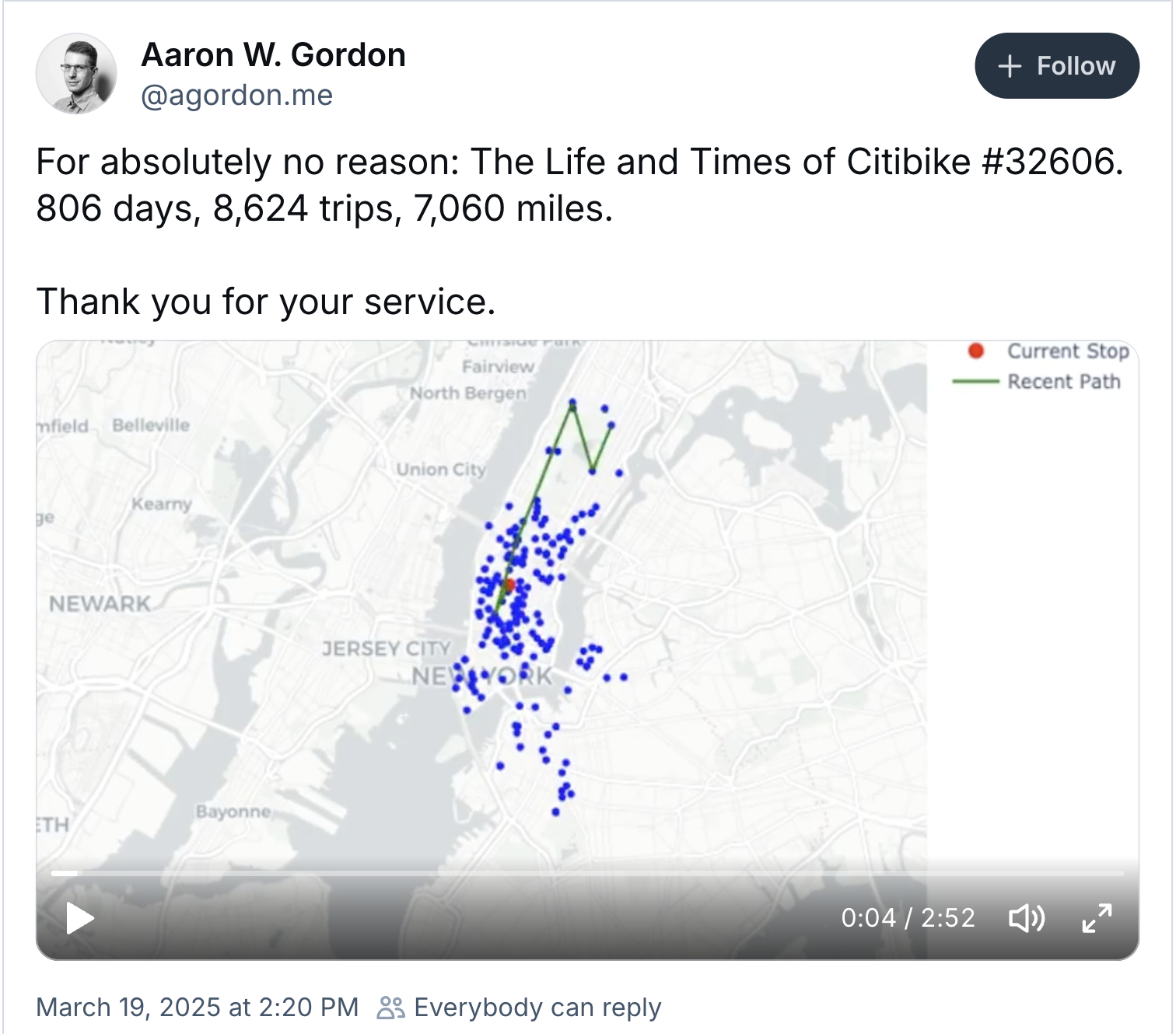| Today we’re bringing you a special edition of MapLab from Aaron Gordon, a reporter on the Bloomberg News data desk. He’s been reporting on transportation and infrastructure, particularly in New York City, for the last eight years. Lately I’ve been working on my coding skills and decided to work with something I knew: Citi Bike’s ride history. I wanted to find the most-used vehicle in New York City’s bikeshare system. Allow me to introduce you to Citi Bike #32606.  A screenshot shows the geographic scope of one mighty Citi Bike. Click on the image to see the interactive with its life’s journey. Citibike #32606 was born on Oct. 15, 2017 at 11:08 a.m. Its first journey began at 3rd St. and Prospect Park West in Park Slope, Brooklyn, on a glorious 70-degree mid-October day. The ride ended at Grand Army Plaza 28 minutes later, barely a half mile away. The rider was not a Citi Bike member, so I suspect a tourist used the weather as an excuse to take a leisurely ride around Prospect Park. The leaves were probably just starting to change. American transportation has become notoriously car-centric in the last century. This reflects a general trend away from shared resources in favor of private alternatives. But bikeshare has been one notable trend in the other direction: A new, shared resource that previously didn’t exist. In an increasingly privatized world, Citi Bike, with its 128,000 active members and growing, feels like a small miracle. Citi Bike #32606 is a miracle within the miracle. Over its 806 days of service (about two years and two months), Citi Bike #32606 was ridden 8,624 times, or an average of 10 times per day. This makes Citi Bike #32606 the most-used traditional bike we know of in the public dataset as of 2020. (In 2020 Citi Bike stopped publishing the unique bike identifier for each trip taken. E-bikes are excluded from this data.) As the crow flies, the total distance covered was more than 7,000 miles, but this is an underestimate of how far Citi Bike #32606 actually traveled because the data only tells us where the bikes docked — not their on-street routes. Still, that 7,000 miles would be enough to go from Times Square to the Santa Monica Pier in Los Angeles and back again, plus a final jaunt up to Burlington, Vermont. Citi Bike #32606 did that distance just on New York City’s streets. And every single one of those 7,000-plus miles was powered by human legs. We know some other things about Citi Bike #32606 and its humans from the data. The median age of its riders was 37 years old. The youngest (or, at least, the youngest rider to legally unlock the bike from a dock) was a series of 16-year-olds on four separate occasions and the oldest was 85 years young. As you can see in the interactive map of the route, Citibike #32606 has roamed in Harlem, done circuits in Chelsea and cycled laps over the Williamsburg Bridge. It's taken a jaunt to Roosevelt Island and a tour of Red Hook. On Sept. 13 and Oct. 26, 2018, Citi Bike #32606 took 62 trips each, marking the bike’s two busiest days of service, hustling around Midtown and the Upper West Side one day and Midtown and Chelsea the other. Since Citi Bike #32606’s reign, the future of the bikeshare service has been uncertain. Lyft, which operates Citi Bike and other cities’ programs, has cut costs and raised prices as it’s struggled to turn consistent profit. Electric bikes now abound, which are ubiquitous and fun, but at 25 cents per minute for members, any bike ride longer than 12 minutes would be cheaper by subway. Whether or not NYC takes a larger role in funding or running the service largely depends on who the next mayor is. At the center of that question is whether Citi Bike is a form of public transportation or an experiment in privatized bikeshare that can live and die by the market. Citi Bike #32606 might have something to say about that. After 8,623 trips, the bike’s final recorded ride was on Dec. 28, 2019, a short hop through the Lower East Side for three blocks. It took a hair over two minutes. It would have been a six-minute walk, but Citi Bike #32606’s last act was still a noble one. It saved someone a couple of minutes. |